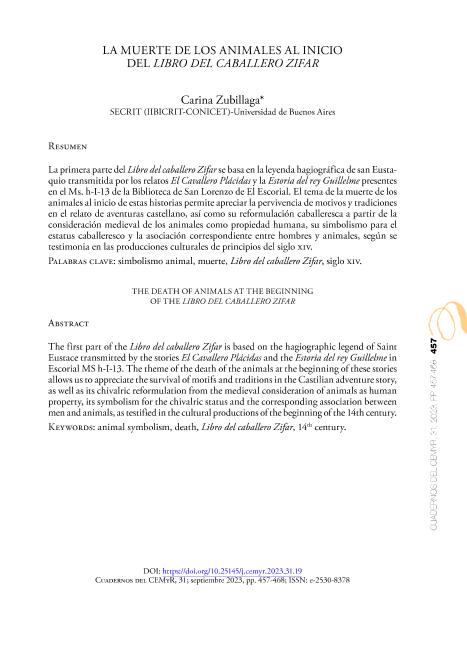Artículo
La primera parte del "Libro del caballero Zifar" se basa en la leyenda hagiográfica de san Eustaquiotransmitida por los relatos "El Cavallero Plácidas" y la "Estoria del rey Guillelme" presentes en el Ms. h-I-13 de la Biblioteca de San Lorenzo de El Escorial. El tema de la muerte de los animales al inicio de estas historias permite apreciar la pervivencia de motivos y tradiciones en el relato de aventuras castellano, así como su reformulación caballeresca a partir de la consideración medieval de los animales como propiedad humana, su simbolismo para el estatus caballeresco y la asociación correspondiente entre hombres y animales, según se testimonia en las producciones culturales de principios del siglo XIV. The first part of the Libro del caballero Zifar is based on the hagiographic legend of Saint Eustace transmitted by the stories El Cavallero Plácidas and the Estoria del rey Guillelme in Escorial MS h-I-13. The theme of the death of the animals at the beginning of these stories allows us to appreciate the survival of motifs and traditions in the Castilian adventure story, as well as its chivalric reformulation from the medieval consideration of animals as human property, its symbolism for the chivalric status and the corresponding association between men and animals, as testified in the cultural productions of the beginning of the 14th century.
La muerte de los animales al inicio del "Libro del caballero Zifar"
Título:
The Death of Animals at the Beginning of the Libro del caballero Zifar
Fecha de publicación:
07/2023
Editorial:
Universidad de La Laguna
Revista:
Cuadernos del Cemyr
ISSN:
2530-8378
Idioma:
Español
Tipo de recurso:
Artículo publicado
Clasificación temática:
Resumen
Palabras clave:
MUERTE ANIMAL
,
ESTATUS ANIMAL
,
CABALLOS
,
ZIFAR
Archivos asociados
Licencia
Identificadores
Colecciones
Articulos(IIBICRIT)
Articulos de INST.DE INVEST.BIBLIOGRAFICAS Y CRITICA TEXTUAL
Articulos de INST.DE INVEST.BIBLIOGRAFICAS Y CRITICA TEXTUAL
Citación
Zubillaga, Carina Alejandra; La muerte de los animales al inicio del "Libro del caballero Zifar"; Universidad de La Laguna; Cuadernos del Cemyr; 2023; 31; 7-2023; 457-468
Compartir
Altmétricas




